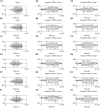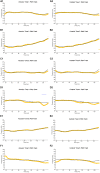Brainstem encoding of speech and musical stimuli in congenital amusia: evidence from Cantonese speakers
- PMID: 25646077
- PMCID: PMC4297920
- DOI: 10.3389/fnhum.2014.01029
Brainstem encoding of speech and musical stimuli in congenital amusia: evidence from Cantonese speakers
Abstract
Congenital amusia is a neurodevelopmental disorder of musical processing that also impacts subtle aspects of speech processing. It remains debated at what stage(s) of auditory processing deficits in amusia arise. In this study, we investigated whether amusia originates from impaired subcortical encoding of speech (in quiet and noise) and musical sounds in the brainstem. Fourteen Cantonese-speaking amusics and 14 matched controls passively listened to six Cantonese lexical tones in quiet, two Cantonese tones in noise (signal-to-noise ratios at 0 and 20 dB), and two cello tones in quiet while their frequency-following responses (FFRs) to these tones were recorded. All participants also completed a behavioral lexical tone identification task. The results indicated normal brainstem encoding of pitch in speech (in quiet and noise) and musical stimuli in amusics relative to controls, as measured by FFR pitch strength, pitch error, and stimulus-to-response correlation. There was also no group difference in neural conduction time or FFR amplitudes. Both groups demonstrated better FFRs to speech (in quiet and noise) than to musical stimuli. However, a significant group difference was observed for tone identification, with amusics showing significantly lower accuracy than controls. Analysis of the tone confusion matrices suggested that amusics were more likely than controls to confuse between tones that shared similar acoustic features. Interestingly, this deficit in lexical tone identification was not coupled with brainstem abnormality for either speech or musical stimuli. Together, our results suggest that the amusic brainstem is not functioning abnormally, although higher-order linguistic pitch processing is impaired in amusia. This finding has significant implications for theories of central auditory processing, requiring further investigations into how different stages of auditory processing interact in the human brain.
Keywords: Cantonese; brainstem; congenital amusia; frequency-following response (FFR); lexical/musical tone; pitch; speech in noise.
Figures

 , ‘doctor’; T2: high-rising, 25,
, ‘doctor’; T2: high-rising, 25,  , ‘chair’; T3: mid-level, 33,
, ‘chair’; T3: mid-level, 33,  , ‘meaning’;
, ‘meaning’;  low-falling, 21,
low-falling, 21,  , ‘son’; T5: mid-rising, 23,
, ‘son’; T5: mid-rising, 23,  , ‘ear’; T6: low-level, 22,
, ‘ear’; T6: low-level, 22,  , ‘two.’ F0 ranges: 138–145 Hz, 107–140 Hz, 121–128 Hz, 87–99 Hz, 100–115 Hz, and 96–106 Hz, respectively.
, ‘two.’ F0 ranges: 138–145 Hz, 107–140 Hz, 121–128 Hz, 87–99 Hz, 100–115 Hz, and 96–106 Hz, respectively.








Similar articles
-
Pitch perception and production in congenital amusia: Evidence from Cantonese speakers.J Acoust Soc Am. 2016 Jul;140(1):563. doi: 10.1121/1.4955182. J Acoust Soc Am. 2016. PMID: 27475178 Free PMC article.
-
Neural bases of congenital amusia in tonal language speakers.Neuropsychologia. 2017 Mar;97:18-28. doi: 10.1016/j.neuropsychologia.2017.01.033. Epub 2017 Jan 31. Neuropsychologia. 2017. PMID: 28153640
-
Deficits of congenital amusia beyond pitch: Evidence from impaired categorical perception of vowels in Cantonese-speaking congenital amusics.PLoS One. 2017 Aug 22;12(8):e0183151. doi: 10.1371/journal.pone.0183151. eCollection 2017. PLoS One. 2017. PMID: 28829808 Free PMC article.
-
Musical and verbal short-term memory: insights from neurodevelopmental and neurological disorders.Ann N Y Acad Sci. 2018 May 9. doi: 10.1111/nyas.13733. Online ahead of print. Ann N Y Acad Sci. 2018. PMID: 29744897 Review.
-
Congenital amusia-pathology of musical disorder.J Appl Genet. 2022 Feb;63(1):127-131. doi: 10.1007/s13353-021-00662-z. Epub 2021 Sep 21. J Appl Genet. 2022. PMID: 34545551 Free PMC article. Review.
Cited by
-
Effects of cTBS on the Frequency-Following Response and Other Auditory Evoked Potentials.Front Hum Neurosci. 2020 Jul 8;14:250. doi: 10.3389/fnhum.2020.00250. eCollection 2020. Front Hum Neurosci. 2020. PMID: 32733220 Free PMC article.
-
Syntactic processing in music and language: Parallel abnormalities observed in congenital amusia.Neuroimage Clin. 2018 May 24;19:640-651. doi: 10.1016/j.nicl.2018.05.032. eCollection 2018. Neuroimage Clin. 2018. PMID: 30013922 Free PMC article.
-
Pitch perception and production in congenital amusia: Evidence from Cantonese speakers.J Acoust Soc Am. 2016 Jul;140(1):563. doi: 10.1121/1.4955182. J Acoust Soc Am. 2016. PMID: 27475178 Free PMC article.
-
Impaired encoding of rapid pitch information underlies perception and memory deficits in congenital amusia.Sci Rep. 2016 Jan 6;6:18861. doi: 10.1038/srep18861. Sci Rep. 2016. PMID: 26732511 Free PMC article.
-
Interactive effects of linguistic abstraction and stimulus statistics in the online modulation of neural speech encoding.Atten Percept Psychophys. 2019 May;81(4):1020-1033. doi: 10.3758/s13414-018-1621-9. Atten Percept Psychophys. 2019. PMID: 30565097 Free PMC article.
References
Grants and funding
LinkOut - more resources
Full Text Sources
Other Literature Sources
Miscellaneous

